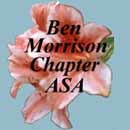
|
| Home |
| Schedule |
| Tours |
| Plants |
| Speakers |
| Registration |
| Hotel |
| Directions |
| Contact |
Best Bloomin' Azaleas in Bay Country
ASA 2004 Convention
Tour B: Baltimore
Friday, May 7, 2004
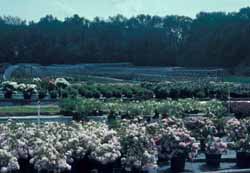
The Baltimore Tour begins at Marshy Point Nursery in Chase, Maryland (right), then visits the garden of Jim Michaels in Kingsville before heading to a gourmet catered lunch and a wander through the Ladew Topiary Gardens in Monkton. After lunch, the private gardens of Bill and Phyllis Meyers and Bill and Ann Mangels will be featured.
Marshy Point is located on two tributaries of the northern Chesapeake Bay and is blessed with a mile of waterfront (maybe not such a blessing after Hurricane Isabel). The nursery produces about 50,000 container plants a year, the majority being azaleas and rhododendrons. While the gardens have many well-established plants, they are integrated with new varieties of azaleas and rhododendrons that are the result of Harry Weiskittel’s hybridization efforts.
The garden of Jim Michaels (pictured below) features a Japanese miniature garden, a beautiful gazebo, a pond, and an allee of perennials and azaleas. “When I was a boy, for a number of years my parents and I would vacation at my mother’s uncle’s shore down towards Annapolis. He owned 800 acres that was almost wilderness—no electricity, water from a spring, coal oil lamps—I loved it,” Jim recalls. “Then one year we came down and almost all the trees were cut down and pushed into piles to make charcoal. There was electricity and the start of many small houses. I was devastated.”
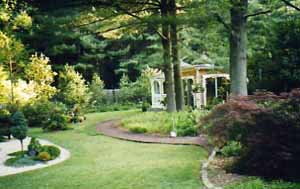
|
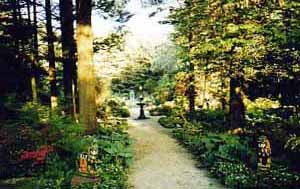
|
“Years later, I bought an old farm house and 20 acres from a speculator. The front and two sides were tomato fields and the back was pasture. As you’ll see, it all has changed. In a small way, I guess it’s a return to ‘yesterday,’” he said.
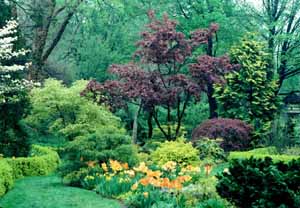 Ladew Topiary Gardens has been called “the most outstanding topiary garden in America” by the Garden Club of America and is on the National Register of Historic Places. Developed between 1929 and 1971 by Harvey Smith Ladew II, the 15 individually themed flower gardens were designed to provide color for every season. Azaleas are featured in the Victorian Garden, Pink Garden, White Garden, Yellow Garden (pictured left), the Portico Garden, and the Garden of Eden (Azalea-Orchard with Gable and other hybrid azaleas). The highlight of the 22 acres is the Topiary Sculpture Garden, which includes a unicorn, sea horses, French hens, and a hunt scene. Ladew had discovered the art of topiary in England in the 1920s during one of his many winter fox-hunting trips. We’ll have lunch in the restored barn—be sure select one of the two options on the Registration Form.
Ladew Topiary Gardens has been called “the most outstanding topiary garden in America” by the Garden Club of America and is on the National Register of Historic Places. Developed between 1929 and 1971 by Harvey Smith Ladew II, the 15 individually themed flower gardens were designed to provide color for every season. Azaleas are featured in the Victorian Garden, Pink Garden, White Garden, Yellow Garden (pictured left), the Portico Garden, and the Garden of Eden (Azalea-Orchard with Gable and other hybrid azaleas). The highlight of the 22 acres is the Topiary Sculpture Garden, which includes a unicorn, sea horses, French hens, and a hunt scene. Ladew had discovered the art of topiary in England in the 1920s during one of his many winter fox-hunting trips. We’ll have lunch in the restored barn—be sure select one of the two options on the Registration Form.
The garden of Bill and Phyllis Meyers is almost 3 acres of lawn and wooded areas surrounding a Victorian house. When the Meyers moved onto the property 31 years ago, the only flowering plants were 3 R. maximum and a few groupings of daffodils. The first 10 azaleas planted were 1-year-old Hershey Red purchased at a nursery. “Mystery” azaleas were acquired over a period of a few months when a local nursery sold the property and had customers dig their own plants. About 6 years ago, they met a member of the American Rhododendron Society (ARS) who was an expert in rooting cuttings. They subsequently joined ARS and ASA and have propagated many plants from cuttings.
Their interest and knowledge continues to grow, and both hold offices in the Mason-Dixon chapter of the ARS; Bill is the current president. At the last flower show held by the club, a Best in Show ribbon was won for an azalea entry. Phyllis is now completing requirements for becoming a Federated Garden Club flower show judge.
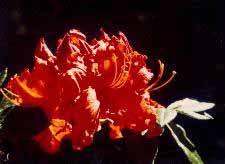 Bill and Ann Mangels describe their garden as a “changing garden, not only by season but also by continued planting of rhododendrons and azaleas.” Their 1-acre garden is surrounded by woods and includes beds with plants that range from fairly new to deciduous azaleas, rhododendrons, evergreen azaleas, and conifers at least 30 years old. Companion plants such as hostas and perennials are also interspersed. “On trips around the country and in England we have gathered plants and seeds. As a result, we have a smattering of Hachmann, Dexter, Gable, Delp, Leach, Robin Hill, Satsuki, Exbury, and natives,” they note.
(Pictured: Exbury Azalea 'Gibraltar')
Bill and Ann Mangels describe their garden as a “changing garden, not only by season but also by continued planting of rhododendrons and azaleas.” Their 1-acre garden is surrounded by woods and includes beds with plants that range from fairly new to deciduous azaleas, rhododendrons, evergreen azaleas, and conifers at least 30 years old. Companion plants such as hostas and perennials are also interspersed. “On trips around the country and in England we have gathered plants and seeds. As a result, we have a smattering of Hachmann, Dexter, Gable, Delp, Leach, Robin Hill, Satsuki, Exbury, and natives,” they note.
(Pictured: Exbury Azalea 'Gibraltar')
NOTE: You must choose between Tour A and Tour B for Friday, May 7, 2004.
The Alternative Friday Tour:
|
|
|
|